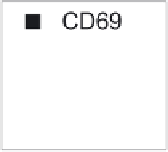Biology Reference
In-Depth Information
F i g u r e 19.2. FACS analysis of T-cell surface markers. Cells were collected from peritoneal cavity
at di¨erent time points after engraftment, as reported on ®gure, and stained with the di¨erent
monoclonal antibodies.
Surprisingly, the generalized impairment of immune functions detected in
the xenochimeras infected at early times was accompanied by the selective up-
regulation of the expression of some cytokines ( IL-4, IL-5, and IL-10) as re-
vealed by RT-PCR. This was reminescent of the T-helper type 2 ( Th2) pro®le
observed in HIV patients experiencing rapid progression of the disease and a
worse prognosis. The switch of Th1 into the Th2 pro®le of cytokine production
has been also suggested to account for the higher rate of CD4
T-cell apotosis
seen in these patients (Clerici et al., 1994). Notably, it has been suggested that
the state of activation of immune cells a¨ects the rate of HIV replication and
disease progression in HIV-infected individuals ( Bentwich et al., 1995; Steven-
son et al., 1990; Wachter et al., 1996). In particular, it has been argued that the
chronic state of immune activation (due to the parasitic and bacterial diseases)
is the major cause of the impressive prevalence and incidence of HIV infection
in Africa as well as of the rapid progression to AIDS in the infected patients
( Bentwich et al., 1995). This is highly consistent with data obtained in simian
immunode®ciency virus (SIV )-infected macaques, where hyperimmune activa-
tion has been shown to accelerate disease progression (Folks et al., 1997). Thus,
the ensemble of experimental data obtained in our modi®ed SCID model sup-
port the concept of the important role of acute or chronic immune activation in
natural infection and in rendering the host more receptive to HIV and more
sensitive to its pathologic e¨ects on the immune functions.
In 1993, Mosier and colleagues published the unexpected ®nding that
macrophage-tropic viruses induced a more rapid loss of CD4 T cells in the hu-
PBL-SCID mice than did the T-cell-tropic isolates, which possessed a high in-




























































